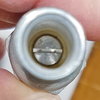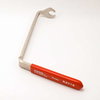The resistance check doesn't find the lead that is arcing from the core out to the shield. This tool does:
View attachment 115461
One of the leads goes to ground, the other goes to the spring on the plug end of the lead. Push the button. If a spark appears in the window, the lead isn't arcing internally. I did the test with the leads still connected to the mags, and if it doesn't spark it might be arcing inside the mag, from the distributor terminal for that wire across to the rotor finger, so turn the prop some to rotate the rotor away from that terminal and test again. It should spark.







